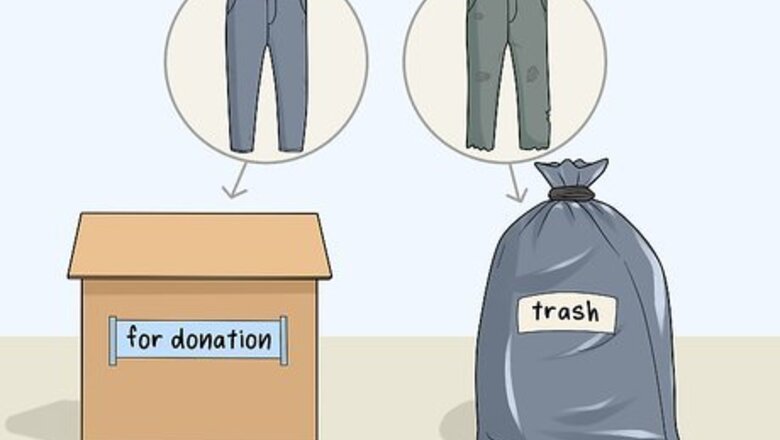
views
Separate all the pants you want to donate or toss.
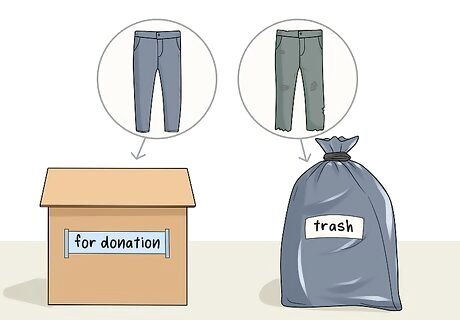
Sorting your pants is the first step to organizing them. Collect all of your pants in one space and go through them, looking at each pair carefully to make sure there aren't any holes or other types of damage. Separate pants that are damaged or don't fit from pants that you intend to keep. If you're not sure whether a pair of pants fits you or not, try them on in front of a mirror to check. If you have pants that you've outgrown or don't want anymore and they're still in good shape, donate them to a friend, family member, or organization like Goodwill or the Salvation Army.
Store seasonal pants in storage containers to save space.
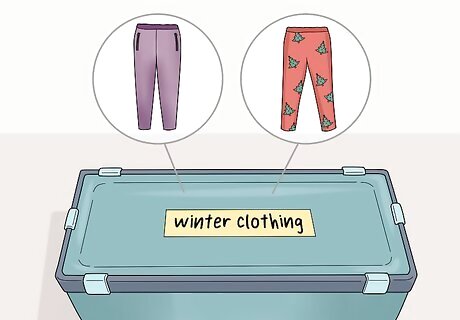
Switch out your clothing each season. Winter slacks, fleece pants, or holiday leggings don’t need to be stored with linen pants and capris that are for warmer months. Keep pants in your closet that you can wear during the current season, and switch these out when the weather gets warmer or colder and it’s time for the others. For example, keep winter pants in an airtight storage container labeled “winter clothing” so you can easily swap out the spring and summer pants for these when it’s time.
Separate the pants that you wear frequently from those you don’t.
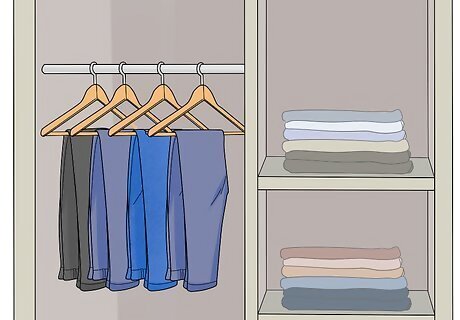
Keep your favorite pants easy to reach. Pants that you wear daily or weekly should be easily accessible and visible, while pants that are only worn on special occasions could be tucked away in the closet. As you're sorting through your pants, make a pile for the pairs that you wear the most often.
Organize pants by color or pattern to see all of your options.
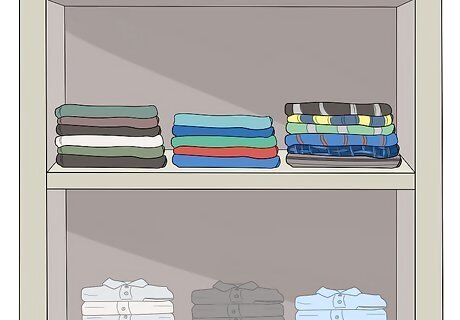
This makes your closet look really tidy. If you have lots of colorful pairs of pants, it can be helpful to arrange them by color or pattern so you can go straight to the section you want. For example, you might have 3 sections: 1 for neutral-colored work pants, 1 for pastel and bright-colored pants, and 1 for patterned pants. If you happen to have many different patterned pairs of pants, you could even separate these, clumping polka dot pants together, striped pants together, and so on.
Arrange jeans from darkest to lightest for easy access.
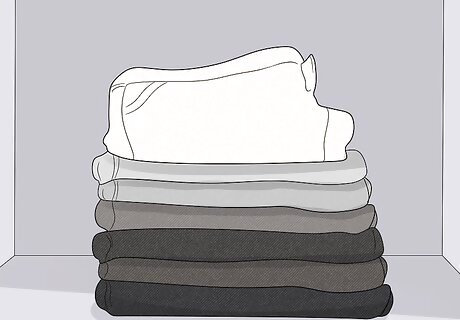
If you have lots of pairs of jeans, a great way to sort them is by their shade. Start with the lightest shade going to the darkest shade, or go the opposite direction and start with the darkest going to the lightest. This makes it easy to quickly find or pick out a specific pair of jeans to wear. For example, hang your jeans in the closet with white jeans at the far left and black jeans on the far right, or fold your jeans with the darkest shade on the bottom and the lightest shade on the top.
Use pants hangers for accessibility and to prevent wrinkles.
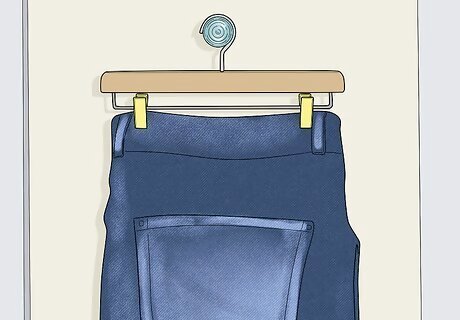
Clip the pants so they’re hanging evenly on the hanger. Hanging pants from pants hangers reduces wrinkles in your pants and makes it easy to go through them when you're looking for something to wear. Buy pants hangers at your local home goods store, big box store, or online.
Fold pants in half to store them on regular hangers.
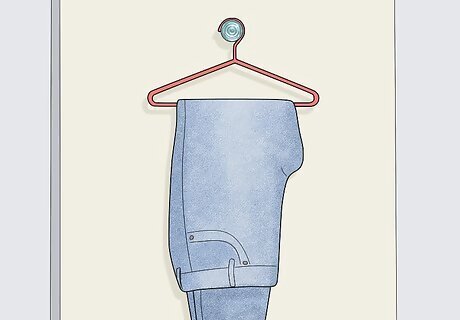
Align a pair of pants so that one leg is folded on top of the other. Pull the pants through the hanger and lay the pants over the bar so the legs hang evenly on each side of the bar. Balancing the pair of pants prevents them from accidentally slipping off.
Purchase a pants organizer to store pants without taking up much space.
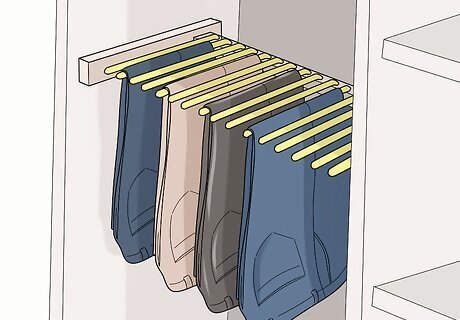
Pants organizers come in lots of different shapes and sizes. In general, though, they all offer a rack to hang several pairs of pants on, saving space in your closet. Fold the pants in half by placing one leg over the other leg, and fold the pair of pants over each peg of the rack. Purchase a pants organizer that goes on the door to your closet or buy one that extends from the wall.
Roll up casual pants to store them in a storage box.
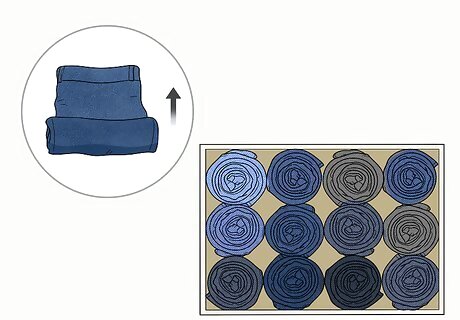
Rolling is a great way to store pants and save space. Fold the pants in half by placing one pant leg over the other, and begin rolling them up, starting at the waist. Place the rolled-up pants in a storage bin, crate, or other container placed in your closet. Place the rolled-up pants close to one another in the storage box so they don’t come unraveled. Label the bin or storage container so you know what's in each one without having to open it. Your pants may get a little wrinkled like this.
Fold pants neatly to stack them on top of one another on a shelf.
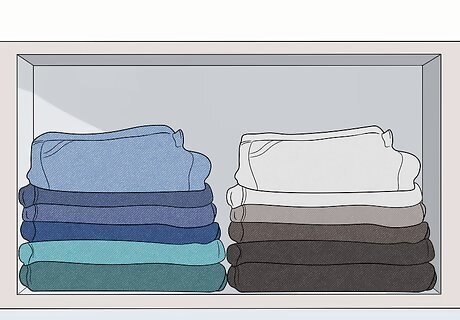
Storing them on a shelf allows you to see each pair of pants that you have. Place one pant leg over the other to fold the pants in half vertically. Then, fold the pair of pants in half horizontally twice to create a square. Stack each pair of folded pants on top of one another neatly. Avoid stacking too many pairs of pants on top of one another or the stack could fall over. 4-6 pairs of pants is a good limit.
Place pants in a drawer by file-folding them.
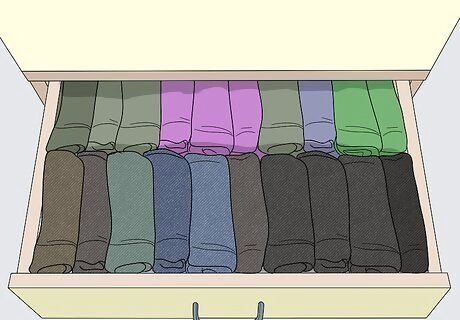
File-folding allows you to see them all at once. Fold your pants into a square just like you would if you were stacking them on top of one another on a shelf. When you’ve created a stack of pants, place the stack on its side in the drawer so that each pair of pants is visible, just like file folders. File folding your pants only works if the entire width of the drawer is filled. This could be because your pants take up the width of the drawer, or because you fill the extra space with something else. Storing your pants vertically instead of stacking them horizontally will make them easier to see and access.
Hang pants on pegs for a decorative look.
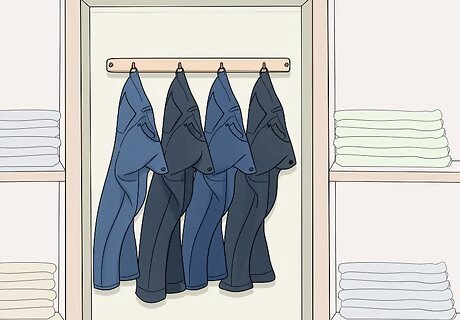
Install pegs in your closet or mount a coat rack on the wall using nails. Hang a pair of pants on a peg using the belt loop, making it easy to see which pants you have available and even easier to hang them from pegs. Install the pegs or hang the coat rack high enough on the wall so your pants aren’t dragging on the floor.



















Comments
0 comment